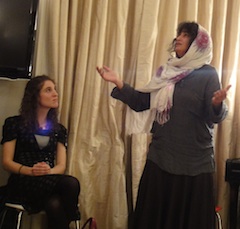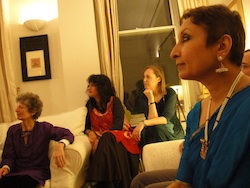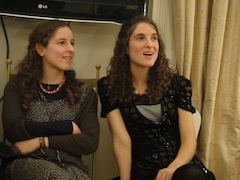| |
|
 |
Faiths telling stories about how we should treat strangers
November 30, 2011:
 |
 |
 |
Benaifer Bhandari tells of the exile of the Zarathushtis |
In 1995 the Climate Institute published the first-ever rigorous assessment of the plight of millions of people displaced as a result of environmental problems. It is clear that increased environmental problems around the world will inevitably lead to more environmental refugees.
But how do those of us living in more ecologically and politically stable regions of the world really treat strangers, and what do the great faiths teach us about this to help us be more compassionate?
ARC has begun to explore these issues not just by working with faiths on formal theologies of the stranger, but with story-telling. And last week, in London, six storytellers told powerful stories from Buddhist, Christian, Daoist, Hindu, Jewish, Muslim and Zoroastrian traditions, drawing both on formal scriptures and informal mythologies and folk tales.
The Muslim StoryWe heard of how the Prophet Muhammad was once seated talking to some important men when a blind man approached him with joy, unable to see that he was busy. And when the Prophet turned away in annoyance he had a revelation of God’s displeasure with him for treating a stranger without compassion. The blind man became a friend of his, and the Prophet learned from his own unkind reaction, and ever after taught that those who followed God should also welcome the poor stranger.
 |
 |
 |
Faiths have told stories about greeting strangers for thousands of years |
The Zoroastrian StoryFrom Zoroastrianism came a story of a woman leaving Iran many generations before for India, as her father had predicted long before. And how the ruler said he had too many people already, and wanted to turn them away, until he was convinced by a wise old priest among the refugees, who simply poured a bowl of sugar into a bowl of milk, and showed how the milk did not spill but was sweetened.
The Daoist StoryThe Daoist story was of Ti Kwai Li, the beautiful young man who wants to be immortal in order to share his beauty through the world. But he leaves his body to go astral travelling and just before he returns, his assistant is called away to visit his dying mother, and Ti Kwai Li has just a few minutes to find another recently vacated body to land in. He finds one just in time, but realises too late that the corpse he has entered is that of an ancient, ugly, hunchbacked beggar: his pride has led him to humility, and he becomes the immortal emblem for those whose bodies are difficult places to inhabit.
Watch the video here.
 |
 |
 |
Anna Conomo and her sister listen to the Jewish story of a beggar visiting a house |
The Hindu StoryThe Hindu story was of a holy man with few clothes and tangled hair, who was looked down upon by the Brahmin priests because he had no caste, and instead of being allowed to worship Krishna, he was led, with his hands behind his back, to the stand on the other side of the wall behind the god’s statue. And yet, by a miracle, the wall breaks open into a window, and the statue of Krishnaturns to face the mendicant; and so today, behind that wall in the temple all kinds of people can come – rich and poor, woman and man and child, beggar and king, and all are said to be equal in the eyes of Krishna.
The Buddhist StoryThe Buddhist story came from the tales of the enlightened being, Guanyin, who was once born as a princess whose father not only disinherited her when she wanted to become a nun, but ordered that the Abbess give her the most terrible and miserable jobs. But then the king became ill, and was told that the only cure was if there were a person who was a stranger to him, who would yet give up their eyes and arms for his cure. There can be no such person, he was sure, but his doctor came back some months later to say that they had the eyes and arms and could now save his life. He discovered that the donor was his own daughter, now blind and without arms, in a cave far away. And when later he went to find her, she said that Buddha would find her a way of continuing to live for the benefit of other sentient beings: and in her father’s presence 1000 eyes and 1000 arms sprang from her body, so she could help many more.
The Christian StoryFrom the Greek Orthodox church came a humourous tale of St Philaret and his selfish wife, who cannot understand why he is giving away all their money.
Watch the video here
The Jewish StoryAnd the Jewish story was of a beggar who comes to the house of a lady who is cooking chicken for some wealthy neighbours. She pretends that the pot is full of laundry and gives him none. He eats the chicken and leaves his vest in the pot. When the wealthy neighbours realize their host had refused food to a stranger they leave, invite the beggar to join them elsewhere, listen to his marvelous stories and give him money for his journey.
The storytellersFrom Buddhism: Martin Palmer - the story of Guanyin
From Orthodox Christianity: Anna Conomos - St Philaret
From Daoism: Martin Palmer - the Daoist immortal, Ti Kwai Li
From Hinduism: Vayu Naidu - Udipi Krishna and Kanakadasa
From Islam: Jumana (Joanna Moon) - The blind man and the Prophet
From Judaism: Adele Moss - Herschele and the boiled chicken
From Zoroastrianism: Benaifer Bhandari - The exile of the Zarathushtis
The hostsOrganised by ARC, this event was filmed by U-Brain TV and hosted by James Kidner of the UK-based charity Coexist, who provided a fine example of welcoming strangers generously into one’s home.
The futureThe plan is to publish these stories, and encourage them to be told in a much wider context.
|
 |
 |
|
|
|
|
|
 |
ARC at a glance
ARC is a secular body that helps the major religions of the world to develop their own environmental programmes, based on their own core teachings, beliefs and practices. |
 |
December 9, 2011:
Bhutan Compassion & Conservation conference: report
The first Compassion and Conservation conference in Bhutan could not have gone better. Sixty-three high lamas, monks and nuns from throughout the country gathered in Thimphu, by invitation from Dratshang Lhentshog, the Commission for Monastic Affairs in Bhutan. The report is now available online. |
 |
December 9, 2011:
Bhutan Compassion & Conservation conference: report
The first Compassion and Conservation conference in Bhutan could not have gone better. Sixty-three high lamas, monks and nuns from throughout the country gathered in Thimphu, by invitation from Dratshang Lhentshog, the Commission for Monastic Affairs in Bhutan. The report is now available online. |
 |
 |
|
|

